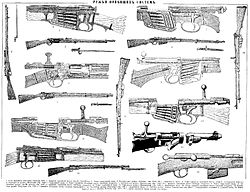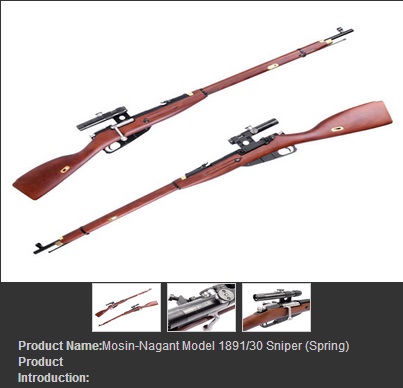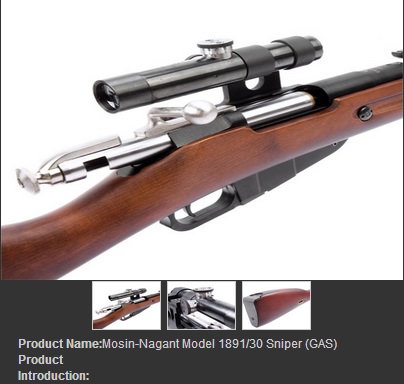Like the Mauser, the bolt lift arc on the Mosin–Nagant is 90 degrees, versus 60 degrees on the Lee-Enfield. The Mauser bolt handle is at the rear of the bolt body and locks behind the solid rear receiver ring. The Mosin bolt handle is similar to the Mannlicher: It is attached to a protrusion on the middle of the bolt body, which serves as a bolt guide, and it locks protruding out of the ejection/loading port in front of a split rear receiver ring, also serving a similar function to Mauser's "third" or "safety" lug.
Despite the failure of Nagant's rifle, he filed a patent suit, claiming he was entitled to the sum the winner was to receive. It appeared that Nagant was the first to apply for the international patent protection over the "interrupter", although he borrowed it from Mosin's design initially. Mosin could not apply for a patent since he was an officer of the Russian army, and the design of the rifle was owned by the Government and had the status of a military secret. A scandal was about to burst out, with Nagant threatening he would not participate in trials held in Russia ever again and some officials proposing to expel Nagant from any further trials as he borrowed the design of the "interrupter" after it was covered by the "secrecy" status given in Russia of that time to military inventions and therefore violated Russian law. Taking into consideration that Nagant was one of the few producers not engaged by competitive governments and generally eager to cooperate and share experience and technologies, the Commission paid him a sum of 200,000 Russian rubles, equal to the premium that Mosin received as the winner. The rifle did not receive the name of Mosin in order not to provoke further debates with Nagant. This turned out to be a wise decision, as in
1895, Nagant's revolver was adopted by the Russian army as the main sidearm. However for the same reason and because of Nagant's attempts to use the situation for publicity, the "Mosin–Nagant" name appeared in the western literature (the rifle was never called this in Russia). The name is a misnomer from the legal point of view (taking into consideration the legal provisions of Russian law at that time, i.e. the law of the country to adopt the rifle) and from technical point of view, as none of the details borrowed from Nagant's design, even if removed, would prevent the rifle from firing. Moreover, from the technical point of view the rifle that came to be called "Mosin–Nagant" (or "Nagant–Mosin") is the design proposed by Mosin, as further amended by Mosin with some details being borrowed from Nagant's design.
Production of the Model 1891 began in 1892 at the ordnance factories of
Tula Arsenal,
Izhevsk Arsenal and at Sestroryetsk Arsenal. An order for 500,000 rifles was placed with the French arms factory,
Manufacture Nationale d'Armes de Châtellerault.
- Model 1891/30 (винтовка образца 1891/30-го года, винтовка Мосина): The most prolific version of the Mosin–Nagant. It was produced for standard issue to all Soviet infantry from 1930 to 1945. Most Dragoon rifles were also converted to the M1891/30 standard. It was commonly used as a sniper rifle in World War II. Early sniper versions had a 4x PE or PEM scope, a Soviet-made copy of a Zeiss design, while later rifles used smaller, simpler, and easier-to-produce 3.5x PU scopes. Because the scope was mounted above the chamber, the bolt handle was replaced with a longer handled, bent version on sniper rifles (known to Mosin collectors and shooters as a "bent bolt") so the shooter could work the bolt without the scope interfering with it. Its design was based on the Dragoon rifle with the following modifications:
- Flat rear sights and restamping of sights in metres, instead of arshinii.
- A cylindrical receiver, replacing the octagonal (commonly called "hex") receiver. Early production 91/30s (from 1930 to 1936) and converted Dragoon rifles retained the octagonal receiver. These rifles are less common and regarded as generally more desirable by collectors.
- A hooded post front sight, replacing the blade on previous weapons.[18]
World War II
At the beginning of the war, the Mosin–Nagant 91/30 was the standard issue weapon of Soviet troops and millions of the rifles were produced and used in World War II by the largest mobilized army in history.
The Mosin–Nagant Model 1891/30 was modified and adapted as a
sniper rifle from 1932 onwards with mounts and scopes from Germany at first and subsequently with domestic designs (PE, PEM) and from 1942 was issued with 3.5-power PU fixed focus scopes to Soviet
snipers. It served quite prominently in the brutal
urban battles on the
Eastern Front, such as the
Battle of Stalingrad, which made heroes of snipers like
Vasili Zaitsev and
Ivan Sidorenko. These sniper rifles were highly respected for being very rugged, reliable, accurate, and easy to maintain. Finland also employed the Mosin–Nagant as a sniper rifle, with similar success with their own designs and captured Soviet rifles. For example,
Simo Häyhä is credited with killing 505 Soviet soldiers, many falling victim to his Finnish M/28-30 Mosin–Nagant rifle.
[12] Häyhä did not use a scope on his Mosin. In interviews Häyhä gave before his death, he said that the scope and mount designed by the Soviets required the shooter to expose himself too much and raise his head too high, increasing the chances of being spotted by the enemy.
In 1935–1936, the 91/30 was again modified, this time to lower production time. The hex receiver (actually octagonal) was changed to a round receiver.
[13] When war with Germany broke out, the need to produce Mosin–Nagants in vast quantities led to a further simplification of machining and a falling-off in finish of the rifles. The wartime Mosins are easily identified by the presence of tool marks and rough finishing that never would have passed the inspectors in peacetime
[citation needed]. However, despite a lack of both aesthetic focus and uniformity, the basic functionality of the Mosins was unimpaired.
In addition, in 1938, a
carbine version of the Mosin Nagant, the M38, was issued. The carbine used the same cartridge and action as other Mosins, but the barrel was shortened by eight inches to bring the weapon down to an overall length of 40 inches, with the forearm shortened in proportion. The idea was to issue the M38 to troops such as combat engineers, signal corps, and artillerymen, who could conceivably need to defend themselves from sudden enemy advances, but whose primary duties lay behind the front lines. Significantly, the front sight of the M38 was positioned in such a way that the Model 91/30's cruciform bayonet could not be mounted to the muzzle even if a soldier obtained one.
The slaughter of the rear area troops, and increase in urban combat, led directly to the development of the Model M44 Mosin. In essence, the M44 is an M38 with a slightly modified forearm and with a permanently mounted cruciform bayonet that folds to the right when it is not needed. In terms of handiness, the M44 was an improvement on the Model 91/30, particularly for urban warfare; but few M44s saw combat on the Eastern Front.
By the end of the war, approximately 17.4 million M91/30 rifles had been produced.
The gun is thought to be referenced in
Hirsh Glick's "
Zog Nit Keyn Mol", the well-known song of the World War II
Jewish partisans, which includes the words "
This song a people sang amid collapsing walls / With Nagants in the hand" (
Yiddish: ??? ????????? ??? ?? ????, mit naganes in di hent); though this refers to the
Nagant revolver, not the Mosin rifle. In the USSR and Russia, the rifle always was called just "Mosin" not "Mosin–Nagant".
Increased world-wide use
In the years after World War II, the Soviet Union ceased production of all Mosin–Nagants and withdrew them from service in favor of the
SKS series carbines and eventually the
AK series rifles. Despite its growing obsolescence, the Mosin–Nagant saw continued service throughout the Eastern bloc and the rest of the world for many decades to come. Mosin–Nagant rifles and carbines saw service on many fronts of the
Cold War, from
Korea and
Vietnam to
Afghanistan and along the
Iron Curtain in Europe. They were kept not only as reserve stockpiles, but front-line infantry weapons as well.
Virtually every country that received military aid from the Soviet Union, China, and Eastern Europe during the Cold War used Mosin–Nagants at various times. Middle Eastern countries within the sphere of Soviet influence —
Egypt,
Syria,
Iraq,
Afghanistan and
Palestinian fighters — have received them in addition to other more modern arms. Mosin–Nagants have also seen action in the hands of both Soviet
[14] and
Mujahadeen forces in
Afghanistan during the
Soviet Union's occupation of the country during the 1970s and the 1980s. Their use in Afghanistan continued on well into the 1990s and the early 21st century by
Northern Alliance forces. Even after the collapse of the Soviet Union, Mosin–Nagants are still commonly found on modern battlefields around the world. They were used by insurgent forces in the
Iraq War and the
current war in Afghanistan. Mosin Nagant rifles have even been seen in the present conflict of the Syrian Civil War, in the hands of rebels.
Separatists have also used the rifles alongside more modern Russian firearms in the
Second war in Chechnya.In addition, scoped Mosins continue to serve as issue sniper rifles with the Afghan Army, the Iraqi Army, the Finnish Army, and with a micrometer sight as a sniper training and precision target rifle with the Finns.
It may be said with justice if one considers sniper rifles as part of a national army's weapons, that the Mosin Nagant is the longest continuously serving firearm in history, at more than 120 years and counting.
The
Model 1891/30 airsoft version ,Mosin–Nagant powered by PPS-airsoft



 PPS-SP-002
PPS-SP-002 PPS-SP-001
PPS-SP-001 PPS-GG-003
PPS-GG-003




